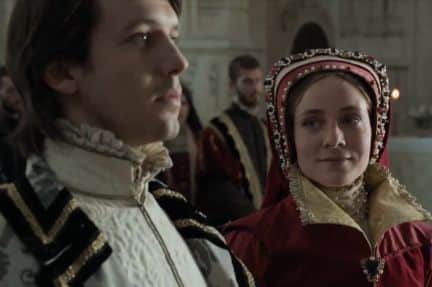
While I think this marriage was overall a bad idea (indeed, in retrospect it would appear she could have chosen better…), I do love weddings. And on this day, it really must have looked to Mary as if her every dream were coming true. I’m going to allow Agnes Strickland to tell the story of the ceremony – Agnes may be extremely Victorian at times, but her descriptions are always fun!
The morrow (being the 25th of July and the festival of St. James, the patron saint of Spain) had been appointed for the royal nuptials. A raised causeway, covered with red serge, leading to two thrones in the choir, had been prepared for the marriage procession. Queen Mary walked on foot from the episcopal palace, attended by her principal nobility and ladies – her train being borne by her cousin, the lady Margaret, assisted by the chamberlain, sir John Gage. She met her bridegroom in the choir, and they took their seats in the chairs of state, an altar being erected between them. Gardiner came in great state, assisted by Chichester, Lincoln, and Ely, with their crosiers borne before them. Philip was attended to the altar by sixty Spanish grandees and cavaliers, among whom were Alva, Medina, Egmont, and Pescara. He was dressed in a robe of rich brocade, bordered with large pearls and diamonds; his trunk-hose were of white satin, worked with silver. He wore a collar of beaten gold, full of inestimable diamonds, at which hung the jewel of the Golden Fleece; at his knee was the Garter, studded with beautiful colored gems.
I just want to break into the narrative to highlight this next bit – brilliant strategy on Spain’s part. England had been negotiating really hard to avoid giving Philip the English crown – the two countries had come to an agreement that the couple were going to retain their own titles…but with this move that same logic meant that yes, England would have to call Philip King:
The ceremony was preceded by a solemn oration from Figueroa, regent of Naples, who declared “that his imperial master, Charles V, having contracted a marriage between the queen of England and his chief jewel – being his son and heir, Philip prince of Spain – in order to make the parties equal had resigned his kingdom of Naples, so that queen Mary married a king and not a prince.” Figueroa then asked in a loud voice, “If there were any persons who knew any lawful impediment between the contracting parties; if so, they might then come forward and be heard.” The marriage, which was both in Latin and English, proceeded till it came to the part of the ceremony where the bride is given. The question was then asked, “Who was to give her?” and it seems to have been a puzzling one, not provided for, when the marquess of Winchester, the earls of Derby, Bedford, and Pembroke came forward and gave her in the name of the whole realm. Upon which the people gave a great shout, and prayed to God to send them joy. The wedding ring was laid on the book, to be hallowed. Some discussion had previously taken place in council regarding this ring, which the queen decided, by declaring she would not have it adorned with gems, “for she chose to be wedded with a plain hoop of gold, like any other maiden.” King Philip laid on the book three handfuls of fie gold coins, and some silver ones. When the lady Margaret, her cousin, saw this, she opened the queen’s purse, and her majesty was observed to smile as she put the bridal gold within it.
I’m going to stop there – avoiding the image I have in my head of Mary waiting for Philip to come to her bedchamber to consummate the marriage, tears running down her face as she watched the candle burn out. That one was planted by The Six Wives of Henry VIII as a way of showing how Philip was not attracted to Mary – which we actually know because he told Ruy Gomez de Silva who reported it back to Spain (“The King is well, and has got over a cold he had a few days ago. He treats the Queen very kindly, and well knows how to pass over the fact that she is no good from the point of view of fleshly sensuality. He makes her so happy that the other day when they were alone she almost talked love-talk to him, and he replied in the same vein…”). Oops…I did go there – hard to avoid it….
***
If you like my posts, you’ll love my books! My Seymour Saga trilogy tells the gripping story of the short-lived dynasty that shaped the Tudor Era. Jane the Quene skews romantic, The Path to Somerset is pure Game of Thrones (without the dragons), and The Boy King is a noir coming-of-age. Get them now through Amazon, Barnes & Noble, Kobo, and Apple, or even your local independent bookstore!

(PS Already read them? Did you love them? Then please review them – even just a stars rating! It makes a huge difference in helping new readers find them and would mean the world to me!)
I believe the scene you speak of is from Elizabeth R, not The Six Wives of Henry VIII (very sad scene though)
You are absolutely right!!
She almost “love talked” to him??? Did they ever have sex? What was wrong with her “flesh”?
They did! And she thought she became pregnant! He just complained to his friends…sigh…